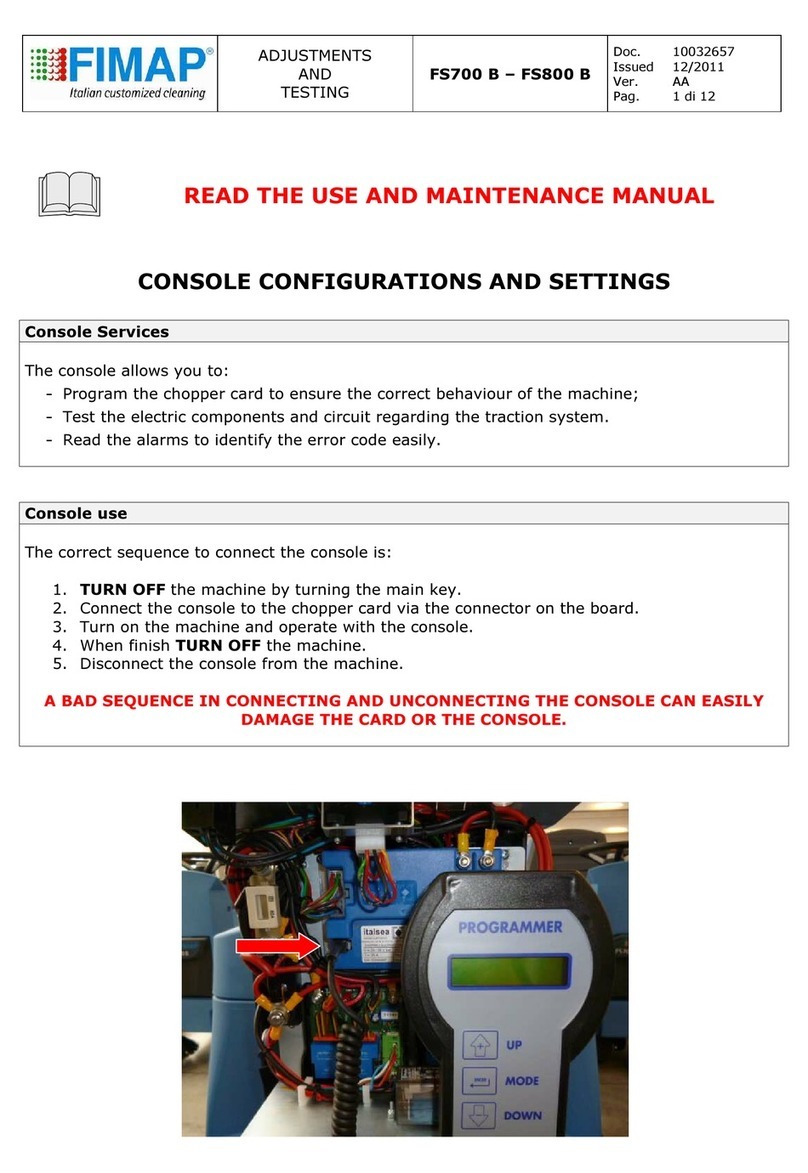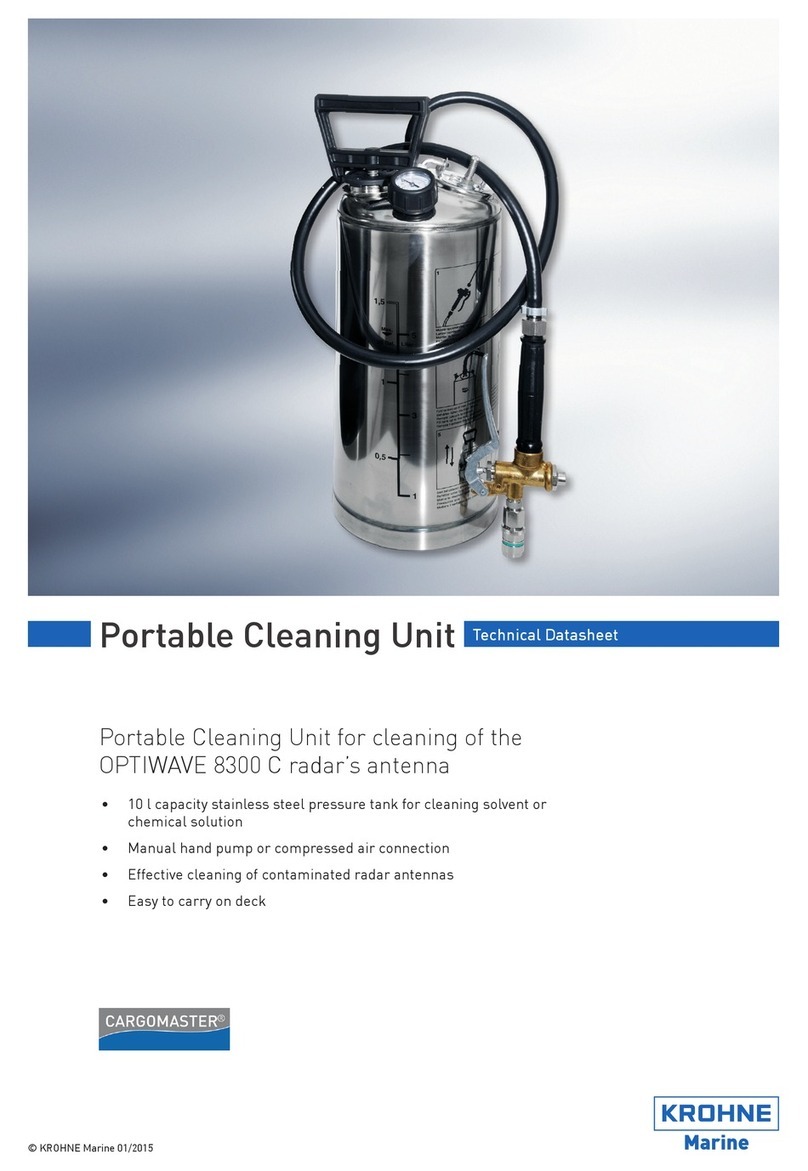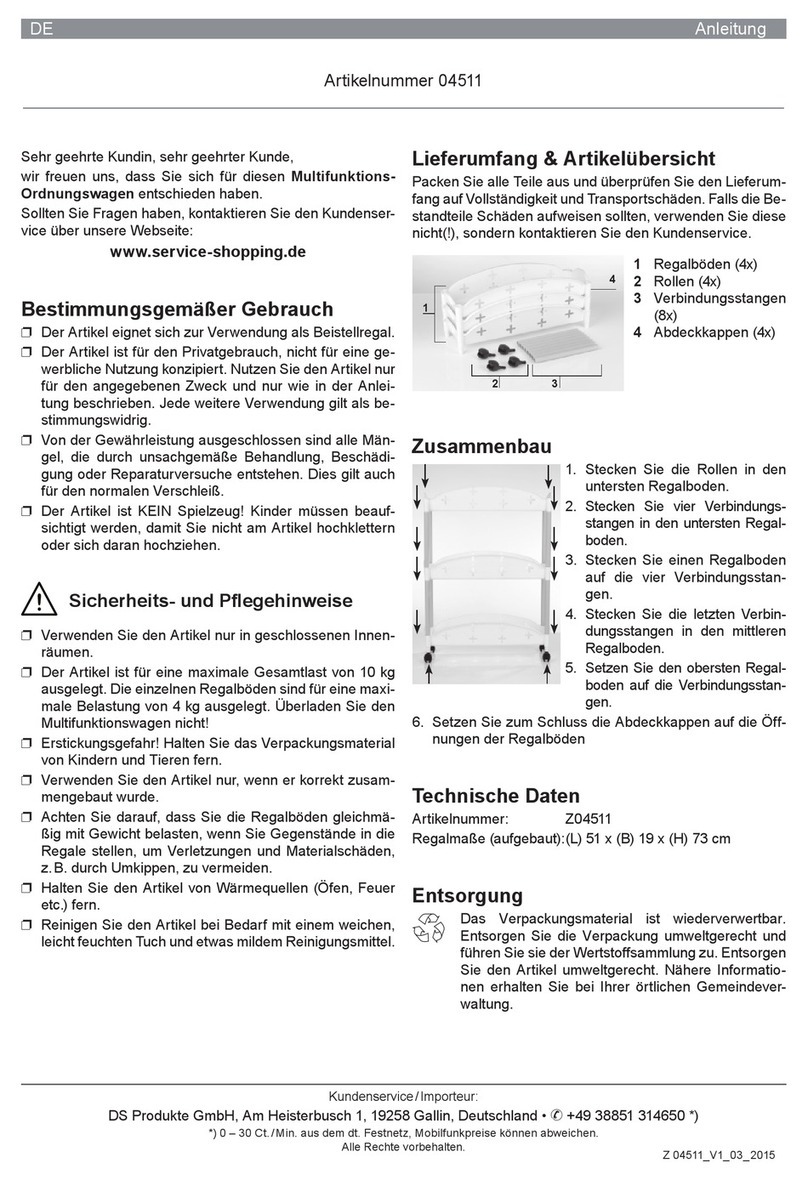Activa SmartMop User manual

User Manual
Activa SmartMop

TARGET GROUP
ON DELIVERY OF THE APPLIANCE
INTRODUCTORY COMMENT
IDENTIFICATION DATA
INTENDED USE
SAFETY
The aim of this manual is to provide customers with all the information needed to use the appliance in the safest, most appropriate
and most autonomous way. It includes information concerning technical aspects, safety, operation, appliance downtime, maintenance,
spare parts and scrapping . Operators and qualified technicians must read the instructions in this manual carefully before carrying out
any operation on the appliance. If in doubt about the correct interpretation of instructions, contact your nearest Customer Service
Centre obtain the necessary clarifications.
This manual is aimed at operators and qualified technicians responsible for appliance maintenance. Operators must not perform
operations that should be carried out by qualified technicians. CLEANWILL cannot be held liable for damages resulting from failure
to comply with this prohibition.
The Use and Maintenance Manual must be stored in its special pouch close to the appliance, protected from liquids and anything
else that could compromise its legibility.
When the machine is delivered to the customer, an immediate check must be performed to ensure all the material mentioned in the
shipping documents has been received, in addition to verifying that the equipment has not been damaged during transportation. If
this is the case, the carrier must ascertain the extent of the damage at once, informing our customer service office. It is only by pro
-mpt action of th is type that the missing material can be obtained,and compensation for damage successfully claimed.
Any type of equipment can only work properly and effectively if used correctly and kept in full working order by performing the maint
-enance operations described in the attached documentation.You should therefore read this instruction manual carefully , consulting
it again if issues arise while using the machine. If necessary, remember that our assistance service ( organised in collaboration with
our dealers) is always available for advice or direct intervention.
For technical assistance or to request replacement parts, always give the model, the version and the serial number (written on the
relevant plate).
The CLEANWILL is a scrubbing machine that cleans a wide range of flooring and dirt types by means of the mechanical action of
the discoidal brush and the chemical action of a water-detergent solution . As it advances, it collects the dirt that has been removed
and the detergent solution that has not been absorbed by the floor.The appliance must only be used for this purpose .
This scrubbing machine was designed and built for the cleaning (scrubbing and drying) of smooth, compact flooring in the commercial,
residential and industrial sectors by a qualified operator in proven safety conditions. The scrubbing machine is not suitable for cleaning
rugs or carpets. The appliance is only suitable for use in indoor - or at least covered - areas.
ATTENTION: the appliance is not suitable for use in the rain,or under jets of water.
IT IS FORBIDDEN to use the appliance for picking up dangerous dusts or inflammable liquids in places with an explosive atmosphere.
In addition, it is not suitable as a means of transport for people or objects.
Operator cooperation is paramount for accident prevention. No accident prevention programme can be effective without the full
co-operation of the operator who is directly responsible for machine operation. The majority of occupational accidents that happen
both in the workplace or whilst moving are caused by failure to respect the most basic safety rules. An attentive, careful operator
is most effective guarantee against accidents and is fundamental in order to implement any prevention programme.
The serial number plate is located inside the device on the
underside of the front housing, and indicates the general appliance
characteristics (in particular, the serial number). The serial number is
a very important piece of information and should always be provided
together with any request for assistance or when purchasing spare
parts.
SERIAL NUMBER PLATE
TECHNICAL DESCRIPTION
STORING THE USE AND MAINTENANCE MANUAL
PURPOSE AND CONTENT OF THE MANUAL

POS QTY DESCRIPTION
1
1
BATTERY
2
1
CONTROL HANDLEBAR
3
1
BRUSH
4
1
SQUEEGEE RUBBER KIT
POS QTY DESCRIPTION
5
1
SOLUTION TANK
6
1
RECOVERY TANK
7
1
CLEAN WATER FILTER
8
2
ANTI-DUST FILTER
9
1
TUBE-CLEANING BRUSH
1
4
2
3
6
5
9
7
8
SPARE PARTS
TECHNICAL DATA U/M XD209
Rated battery voltage
V/mAh
24/
6000
Weight
kg
10
Air fow
L/S
14.66
Noise
dB(A)
<70
Fully charging time
h
1.5
Running time
min
60
Vacuum degree
KPa
4
Product size
mm
406×
447×230
TECHNICAL DATA U/M XD209
Total power
W
150
Working width
mm
350
Suction width
mm
422
Brush(diameter×length)
mm×mm
110×352
Brush speed
rpm
350
Brush motor(rated)
V/W
24/32
Vacuum motor(rated)
V/W
24/100
Solution tank capacity
l
2
Recovery tank capacity
l
1.5

OFF
1
1
2
3
2
3
4
CLICK
4
7
HOW TO UNPACK THE APPLIANCE
The procedure for removing the device from its packaging is the
following:
1.
Place the lower part of the outer packaging in contact with the floor.
ATTENTION: use the pictograms printed on the box as a
reference.
2.
Open the outer box.
3.
Remove the accessoriesfrom the box and carefully lay them on
the ground.
4.
Take the appliance out of the box.
ATTENTION: it is recommended that all the packaging
components be kept for any future transportation of the
appliance.
ATTENTION: these operations must be carried out using
protective gloves to avoid any possible contact with the
edgesor tips of metal objects.
HOW TO TRANSPORT THE APPLIANCE
The procedure for the safe handling of the device is the following:
1.
If the appliance is working ,tum it off via the main switch(1)
(Fig. 1).
2.
Make sure the recovery tank is empty . If it isn't , empty
itcompletely.
3.
Make sure the solution tank is empty . If it isn't , empty it
completely.
4.
Remove the power battery (2) from the appliance . To free the
battery, shift the stop lever (3) in the direction of the arrow
(Fig.2).
7.
Rotate the stop l ever of the command handlebar (4) in the
direction of the arrow (Fig.5).
8.
Close the command handlebar,pushing the handle (5) towards
the main part of the appliance(Fig.6).
9.
Rotate the stop lever of the command handlebar (4) in the
direction of the arrow (Fig.7).
10.
To raise the device off the floor, use the handle (6) on its rear
(Flg.8).
5.
Remove the battery from the appliance using the handle
moulded on it (Fig.3).
6.
Block the handlebar in the horizontal position . Rest your foot
on the main part of the appliance to prevent it from tilting, then
push the handle away from you until it snaps into the horizontal
position (Fig.4).
ATTENTION: do not rest your foot on the main switch.
ATTENTION: when transporting the appliance on vehicles,
secure it frmly in place in accordance with the directives in
force so that it cannot slide or tip over.
ATTENTION: these operations must be carried out using
protective gloves to avoid any possible contact with the
edges or tips of metal objects.
5
6
4
5
!
!
!
!
8
6

7
6
5
8
6
BATTERY TYPE
To power the appliance, use only t he battery supplied in the
package or by a specialised technician.
OTHER BATTERY TYPES CANNOT BE USED.
The appliance is powered by a lithium-ion battery. The battery
compartment can accommodate a single battery slot at 24V.
ATTENTION:
for the maintenance and disposal of the
battery read the document supplied by the battery
manufacturer.
RECHARGING THE BATTERY
The battery must be charged prior to the first use, and when it
doesn't provide enough power for tasks that could formerly be
performedwithout difficulty. To recharge the battery, proceed as
follows:
1.
Take the appliance to the dedicated battery recharging area.
ATTENTION: the room where the batteries are recharged
must be adequately ventilated to prevent the accumulation
of gases that leak from batteries.
2.
If the appliance is working, turn it off via the main switch (1)
(Fig. 1).
3.
Block the handlebar in the vertical position.
ATTENTION: during this operation, do not rest your foot
on the appliance .
before inserting the power plug (2) in the power supply unit (3)
(Fig.2).
ATTENTION:
before connecting the battery charger to
the socket, make sure the characteristics of the mains ,
supply correspond to those of the battery charger.
ATTENTION: the battery charger must only be used in a
covered place.
5. Connect the power plug (2) to the mains supply.
ATTENTION:
make sure the green LED (4) on the
battery charger lights up when you enable the battery
charger base circuit(Fig.3). This LED indicates that the
charger circuit is correctly powered.
4. Read the battery charger manual (supplied with the device) 6. Remove the cap (3) covering the battery power socket (Fig.3).
7.
Insert the battery charger power cable plug (6) in the socket (7)
on the battery (Flg.5).
ATTENTION: make sure the green LED (4) on the battery
charger lights up when you enable the charger (Fig.3). This
LED indicates thai the charger circuit is correctly powered.
ATTENTION: before inserting the plug (6) in the socket (7),
make sure the battery charger housing compartment is not
dirty (dust, condensation or other types of liquid) .
ATTENTION:
make sure the red LED (4) on the battery
charger lights up when you insert the plug (6) in the
socket (7). This LED Indicates that the battery is
recharging.
8.
Perform a complete battery charging cycle.
ATTENTION: the red LED (4) remains on until the battery is
fully charged. When the recharging cycle has ended,the red
LED goes off and the green LED comes on.
ATTENTION: the charger and the battery can be left
connected to the power socket. The red LED (4) light up
when the charger occasionally tops up the battery.
ATTENTION:
the red charge status LED (4) does not
provide any indication of the battery charge level.
ATTENTION:
during the charging phase , the battery
may overheat. This is normal and does not mean there
is any problem with the battery.
ATTENTION:
if the battery used in this appliance is
overcharged , there may be a risk of fire, explosion or
chemical bums.
OFF
1
1
!
!
!
!
!
!
!
!
!
!
2
2
3
4
3
5
4

4
4
5
5
9.
Once the charging cycle is completed ( the green LED (8)
fully lights up
)
, remove the plug (2) on the battery charger
from the mains socket (Flg.6).
ATTENTION: to prevent any damage to the mains socket,
pull directly on the plug (not on the cable) when taking it out.
10.
Take the power cable plug (6) out of the socket (7) on the
battery.
11.
Insert the cap (5) that covers the battery power socket.
PREPARING THE APPLIANCE
1.
Take the package to the dedicated maintenance area.
2.
Remove the appliance and all the accessories from the box.
3.
Insert the lower tube (1) of the control handlebar in the hole
on the joint (2) (Flg.1).
4.
Fix the handlebar to the joint using the screw and nut (3),
making sure the hole on the handlebar coincides with the
hole on the joint (Fig.2).
ATTENTION:
the screwdriver is not supplied.
5.
Block the handlebar in the horizontal position . Rest your
foot on the main part of the appliance to prevent it from
tilting, then push the handle away from you until it snaps
into the horizontal pOSition (Fig.3).
ATTENTION:
do not rest your foot on the main switch.
6.
Rotate the stop lever of the handlebar (4) in the direction
of the arrow (Fig.4).
8. Rotate the stop lever of the handlebar (4) in the direction
of the arrow (Fig.6).
7. Close the command handlebar, pushing the handle ( 5 )
towards the main part of the appliance(Fig.5).
9. Insert the battery (6) in the battery-holder compartment(7)
in the rear part of the appliance (Fig.7) . Push the battery
until the uncoupling lever (8) locks into place.
6
7
7
8
4
6
CLICK
3
3
3
2
1
2
1
!
!

PREPARING TO WORK
Before beginning to work, it is necessary to:
ATTENTION: before beginning the first work cycle , fully
recharge the battery (read "RECHARGING THE BATTERY").
1.
Before using the appliance, make sure it is in a good , safe
working condition. If everything is not in order, the appliance
must not be used.
2.
Rotate the handlebar so it is vertical.
ATTENTION: during this operation, do not rest your foot on
the appliance.
3.
Activate the appliance using the main switch (1) (Fig.1).
ATTENTION: if the LED of the main switch (1) (Fig.1)
is lit up,this means the electrical system of the appliance
is activated.
4.
Check the battery charge level. There are four LEDs (2) on the
battery to show the charge percentage (Fig.2). If all the LEDs
are lit up, the battery is fully charged; if they are all switched
off,the battery is completely run down.
5.
Deactivate the appliance using the main switch (1) (Fig.3).
6.
Remove the power battery (3) from the appliance. To free the
battery, shift the stop lever (4) in the direction of the arrow
(Fig.4).
7.
Remove the battery from the appliance using the handle
moulded on it (Fig.5).
8.
Make sure the condition of the squeegee rubbers is suitable
for the work you want to carry out . If it isn't , perform the
necessary maintenance (read "MAINTENANCE").
9.
Make sure the condition of the brush is suitable for the work
you want to carry out . If it isn't , perform the necessary
maintenance(read " MAINTENANCE").
10.
Rotate the front carter (5) as far as it will go - do this with the
aid of the handle (6) (Fig.6).
ATTENTION: these operations must be carried out using
protective gloves to avoid any possible contact with the
edges or tips of metal objects.
11.
Remove the solution tank from the device (Fig.7). Carefully
place it on the foor.
12.
Remove Ihe detergent solution filling cap (7) from its seat
on the solution tank (Fig.8).
13.
Fill with clean water, at a temperature no higher than 50
℃
and no lower than 10
℃
.
14.
Add the liquid detergent to the solution tank in the
concentration and manner indicated on the detergent
manufacturer's label.
ATTENTION:
the formation of excess foam could
damage the vacuum motor, so use only the minimum
amount of detergent necessary.
ATTENTION:
always use detergents whose manufacturer's
label indicates their suitability for scrubbing machines. Do
not use acid or alkaline products or solvents without this
indication. Acid or alkaline maintenance detergents can be
used, as long as they have pH values between four and ten ,
and do not contain oxidising agents, chlorine or bromine,
fonnaldehyde, mineral solvents.
ATTENTION: protective gloves should always be worn
before handling detergents or acidic or alkaline solutions,
to avoid serious injury to the hands.
ATTENTION: always use low-foam detergent.To avoid the
production of foam, put a minimum quantity of antifoam liquid
in the recoverytank beforestartingto clean. Donot use pure
acids.
15.
Replace the detergent solution filling cap (7) in its seat on
the solution tank (Fig.9).
ATTENTION:
it is good practice to empty the recovery
tank every time you top up the solution tank level.
16.
Insert the solution tank in the device (Flg.10).
17.
Rotate the front carter (5) as far as the work position - do
this with the aid of the handle (6) (Flg.11).
18.
Insert the battery in the battery-holder compartment in the
rear part of the device.
7
8
7
5
6
3
5
6
3
2
4
OFF
1
3
2
2
ON
1
1
!
!

WORK
Before beginning to work, it is necessary to:
1. Carry out the operations described in the "PREPARING TO
WORK" chapter.
2. Check that the squeegee body is in contact with the surface
to be cleaned. If it isn't , turn the knob (1) in the direction of
the arrow (Fig.1 ).
ATTENTION: Fig.1 shows the left side of the device. Rotate
the knob on the right-hand side in the opposite direction .
3. Release the handlebar from its vertical position and rotate it
towards you .
ATTENTION: during this operation, do not rest your foot on
the appliance.
4. Adjust the control handlebar.
5. Activate the appliance using the main switch (2) (Fig.2).
ATTENTION: if the LED of the main switch (2) (Fig.2) is lit
up, this means the electrical system of the appliance is
activated.
ATTENTION: as soon as the device has been activated,
the front LEDs will light up and both the brush motor and
the vacuum motor will start working.
6. Activate the detergent solution supply by pressing the electric
pump control switch (3) (Fig.3).
ATTENTION:
if the LED of the electric pump control
switch (3) (Fig.3) is active, this means the pump will
supply detergent solution.
7. The appliance will now begin to work with full efficiency until
the battery is flat or until the detergent solution runs out.
ATTENTION: the joint on the device guarantees greater
manageability. To make a left-hand tum, rotate the handle
to the left (Fig.4); rotate it to the right when you want to
tum right.
ATTENTION: if you need to tum back while you are working,
justrotatethe deviceby1800byrotatingthecontrolhandle.
ATTENTION: if you need to tum back while you are working,
justrotatethe deviceby1800byrotatingthecontrolhandle.
ATTENTION: if the handlebar is placed in the idle position
(vertical) during use, the brush motor and electric pump will
stop working. After a few seconds, the vacuum motor will
switch off as well.
ATTENTION: if the charge level reaches a certain value
during use, the brush motor and the electric pump will stop
working. After a few seconds, the vacuum motor will switch
off automatically as well. Both the LED of the main switch
and that of the electric pump control switch will remain ON.
4
3
3
ON
2
1
1
2
6
5
11
10
7
9
!
!
!
!
!
!
!
!
!
!

OFF
1
1
2
2
5
6
5
7
6
3
4
3
4
8
7
8
AT THE END OF THE WORK
At the end of the work, and before carrying out any type of
maintenance, perform the following operations:
1. Deactivate the appliance using the main switch (1) (Fig.1).
2. Rotate the handlebar so it is vertical.
ATTENTION: during this operation, do not rest your foot on
the appliance.
3. Raise the squeegee off the floor and rotate the knob (2) in the
direction of the arrow (Fig.2).
7. Rotate the front carter (5) as far as it will go - do this with the
aid of the handle (6) (Fig.5).
ATTENTION: these operations must be carried out using
protective gloves to avoid any possible contact with the
edges or tips of metal objects.
8. Remove the recovery tank (7) from the appliance( Fig.6).
9. Remove the recovery tank cover (8) (Fig.7).
15.
Remove the detergent solution filling cap (9) from its seat on
the solution tank (Fig.9).
16.
Empty the tank.
17.
Rinse the inside of the tank with a jet of water.
18.
Replace the de, ergent solution filling cap (9) in its seat on
the solution tank (Fig.10).
ATTENTION:
Fig. 2 shows the Ieft side of the device.
Rotate the knob on the right-hand side in the opposite
direction.
4. Take the appliance to the dedicated waste water drainage
area.
ATTENTION: The place given over to this operation must
comply with current environment I protection regulations.
5. Remove the power battery (3) from the appliance. To free
the battery, shift the stop lever (4) in the direction of the
arrow(Fig.3).
6. Remove the battery from the appliance using the handle
moulded on it (Fig.4).
ATTENTION: protective gloves should always be worn
before handling detergents or acidic or alkaline solutions,
to avoid serious injury to the hands.
10.
Empty the tank.
11.
Rinse the inside of the tank with a jet of water. If necessary ,
use a spatula to remove the sludge that has accumulated at
the bottom.
12.
Position the recovery tank cover (8) on the tank.
13.
Fix the cover on the tank.
14.
Remove the solution tank from the device (Fig.8) .
19.
Insert the two tanks in the appliance, positioning first the solution
tank and then the recovery tank.
20.
Rotate the front carter (5) as far as the work position - do this
with the aid of the handle (6) (Fig.11).
21.
Block the handlebar in the horizontal position(Fig.12).
!
!

13
15
16
ATTENTION: during this operation,do not rest your foot on
the appliance.
22.
Rotate the stop lever of the command handlebar (13) in the
direction of the arrow (Fig.13).
23.
Close the command handlebar, pushing the handle (14) towards
the main part of the appliance (Fig.14).
24.
Rotate the stop lever of the command handlebar (13) in the
direction of the arrow (Fig.15).
25.
Take the appliance to the designated storage area.
26.
Position the appliance with its rear part in contact with the
floor (Fig.16)
ATTENTION: the joint on the device guarantees greater
manageability. To make a left-hand tum, rotate the handle
to the left (Fig.4); rotate it to the right when you want to
tum right.
MAINTENANCE
At the end of the work, and before carrying out any type of
maintenance, perform the following operations:
1. Deactivate the appliance using the main switch (1) (Fig.1 ).
2. Rotate the handlebar so it is vertical.
ATTENTION: during this operation, do not rest your foot on
the appliance.
3. Take the device to the dedicated maintenance area.
ATTENTION: The place given over to this operation
must comply with current environmental protection regulations.
4. Remove the power battery (2) from the appliance. To free the
battery, shift the stop lever (3) in the direction of the arrow (Fig.2).
5. Remove the battery from the appliance using the handle moulded
on it (Fig.3).
6. Rotate the front carter (4) as far as it will go - do this with the
aid of the handle (5) (Fig.4).
4
5
6
2
3
3
2
4
OFF
1
1
14
14
13
13
12
CLICK
6
5
11
9
10
9
9
!
!

ATTENTION: these operations must be carried out using
protective gloves to avoid any possible contact with the
edges or tips of metal objects.
7. Remove the tunnel cover (6) and shift the stop levers (7) as
indicated by the arrows (Fig.5)
8. Remove the brush (8) from the appliance (Fig.6).
ATTENTION: during this process, keep the control handlebar
still, in order to prevent the appliance from moving
accidentally.
9. Clean the brush under running water to remove any impurities
present in the bristles. Check that the bristles are not worn;in the
event of excessive wear, replace the brush (the bristles should be
at least 10 mm long).
10. Fit the brush (8) on the pin in the brush motor (the brush can only
be inserted in one direction) (Fig.7).
11. Replace the tunnel cover (6) and shift the stop levers (7) as
indicated by the arrows (Fig.8).
12. Remove the recovery tank (9) from the appliance .
13. Remove the recovery tank cover (10) (Fig.10).
14. Use a jet of water and then a damp cloth to thoroughly clean the
rotation fulcrum (11) of the vacuum motor floats (Fig.11).
15. Use a jet of water and then a damp cloth to thoroughly clean the
central float (12) (Fig.12).
16. Clean the dirty water conveyor compartment with a jet of
water; the entrance hole to this compartment is identifed by the
letter (A), while the outlet is identifed with the letter (B) (Fig.13).
17. Clean the vacuum motor air conveyor compartment with a jet
of air; the entrance hole to this compartment is identifed by the
letter (C), while the outlet is identifed with the letter (D) (Fig.14).
18. Fix the cover on the recovery tank.
19. Remove the solution tank from the device (Fig.15).
20. Remove the flter cartridge (13) and clean it under a jet of water
to remove any dirt that might be attached. If necessary, replace
it (Fig.16).
21. Remove the vacuum duct cleaning brush (14) from its support
(Fig.17).
22. Clean the inside of the vacuum duct (15) with the brush (14)
(Fig.18).
23. Replace the vacuum duct cleaning brush (15) on its support
(Fig.19).
24. Rotate the front carter (4) as far es the work position - do this with
the aid of the handle (5) (Fig.20).
13
166
15
D
C
14
A
B
13
12
162
11
11
10
10
9
9
7
6
68
8
6
7
7
6
5
!

25
18
27
268
25. Block the handlebar in the horizontal position (Fig.21).
ATTENTION: during this operation, do not rest your foot on
the appliance.
26. Rotate the stop lever of the command handlebar (16) in the
direction of the arrow (Fig.22).
27. Close the command handlebar, pushing the handle (17) towards
the main part of the appliance(Fig.23).
28. Rotate the stop lever of the command handlebar (16) in the
direction of the arrow (Fig.24).
29. Position the appliance with its rear part in contact with the floor
(Fig.25).
30. Make sure the squeegee is in the work position. If it isn't, rotate
the knob (18) in the direction of the arrow (Fig.26).
ATTENTION: carry out this operation for both the left-hand
knob and the right-hand knob.
32. Use a damp cloth to thoroughly clean the vacuum chamber of the
squeegee (19) (Fig.29).
ATTENTION: be careful not to lose or damage the seal (20)
above the vacuum nozzle (Fig.29).
ATTENTION: during this operation, do not rest your foot on
the appliance.
31. Bring the squeegee coupling to the maintenance position and
shift the knob (18) outwards (Fig.27). Rotate the squeegee
coupling towards you (Fig.28).
33.
Use a damp cloth to thoroughly clean the vacuum chamber of the
squeegee (21) (Fig.30).
34.
Use a damp cloth to thoroughly clean the front rubber of the
squeegee (22) (Fig.31). Check the condition of the front rubber
blade; if the edge that is in contact with the floor is worn, replace it.
35.
Use a damp cloth to thoroughly clean the rear rubber of the
squeegee (23) (Fig.32). Check the condition of the rear rubber
blade; if the edge that is in contact with the floor is worn, replace it.
23
362
22
21
30
31
19
19
29
20
5
4
20
14
15
18
17
14
17
!
!
!
!
21
CLICK
16
22
17
23
18
26
16
24

24
33
34
35
18
366
27
28
41
25
42
Careful maintenance of the squeegee rubbers guarantees better
cleaning and drying of the floor, as well as a longer vacuum motor
life. To replace the squeegee rubbers, proceed as follows:
•Tum the wing nuts (24) that hold the squeegee by 90°
(Fig.33).
•Remove the squeegee from the slots on the squeegee
connector, taking care not to lose the seal on the vacuum
nozzle (Fig.34).
ATTENTION: Fig.37 shows the left side of the device. Rotate
the knob on the right-hand side in the opposite direction.
38.
Remove the exhaust air filter support (25) from the appliance by
pressing the fixing tab (26) in the direction of the arrow (Fig.38).
39.
Clean the filter cartridges (27) with a jet of air (Fig.39), from a
distance of at least 20 cm.
•Replace the worn/damaged rubber.
•Repeat the operations in reverse order to reassemble all the
parts.
36. Bring the squeegee coupling to the idle position and shift the
squeegee towards the appliance (Fig.35).
37. Fix the squeegee coupling in the idle position. Push the knob (18)
towards the appliance (Fig.36), then rotate it in the direction of
the arrow (Fig.38).
Careful maintenance of the exhaust air filters guarantees a longer
vacuum motor life. To replace the filter cartridges, proceed as
follows:
•Remove the filter cartridge supports (28) from the filter
support (Fig.40).
•Remove the wom filter cartridge (27) from the filter cartridge
support (28) and replace it with the new one (Fig.41).
•Repeat the operations in reverse order to reassemble alt the
parts.
43. Rotate the front carter (4) as far as it will go - do this with the aid
of the handle (5) (Fig.45).
44. Insert the two tanks and the detergent solution filter cartridge
in the appliance, positioning first the detergent solution filter
cartridge, then the solution tank, and finally the recovery tank.
45. Rotate the front carter (4) as far as the work position - do this with
the aid of the handle (5) (Fig.46).
40. Insert the exhaust air filter support (25) in the appliance (Fig.42).
41. Rotate the appliance to its work position (Fig.43).
42. Block the handlebar in the vertical position; to release the
handlebar, move the stop in the direction of the arrow (Fig.44).
46. Insert the battery in the battery-holder compartment in the rear
part of the appliance (Fig.47).
47. Position the appliance with its rear part in contact with the floor
(Fig.48).
ATTENTION: Park the appliance in an enclosed place, on a
flat surface; near the appliance there must be no objects that
could either damage it, or be damaged through contact wilh it.
48
47
4
5 5
4
45
46
28
460
27
27
39
26
25
38
18
37
!
5
4
464
43

Table of contents
Popular Cleaning Equipment manuals by other brands

Berkshire
Berkshire Cleanroom Mop Cart with Buckets Installation instruction

aci
aci JetBlack Installation, operation and maintenance instructions manual
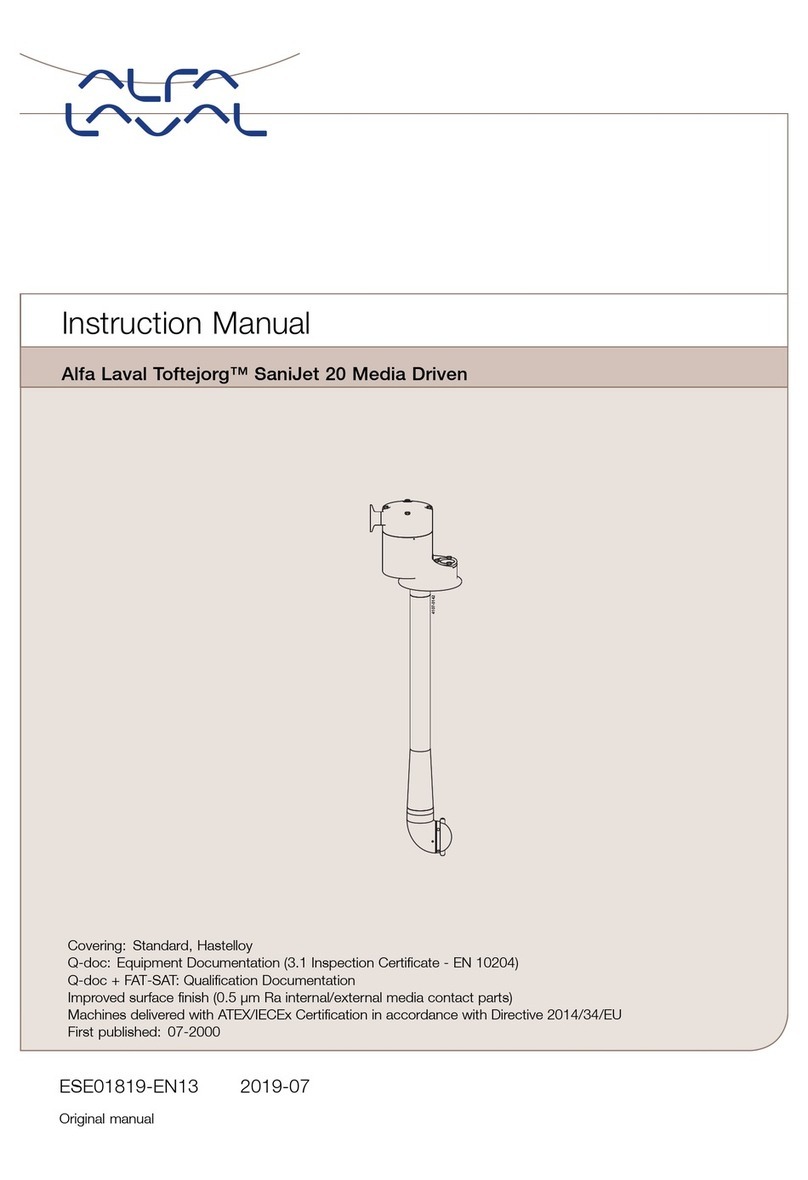
Alfalaval
Alfalaval Toftejorg SaniJet 20 instruction manual
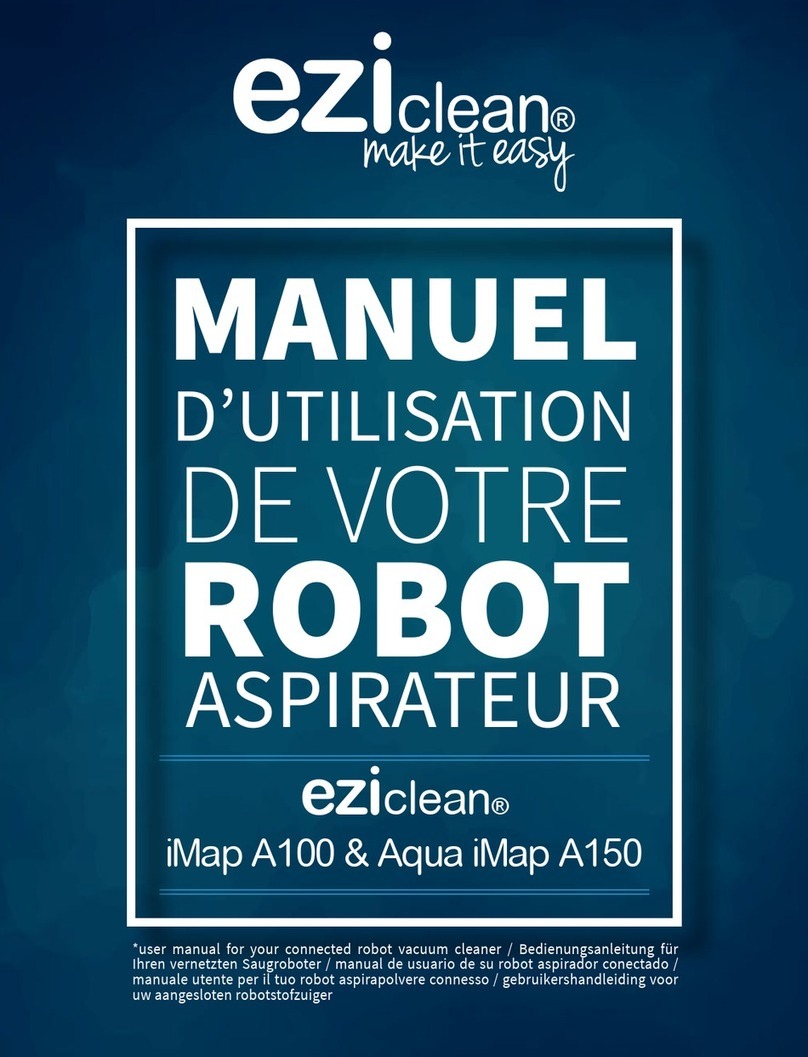
e.ziclean
e.ziclean iMap A100 manual
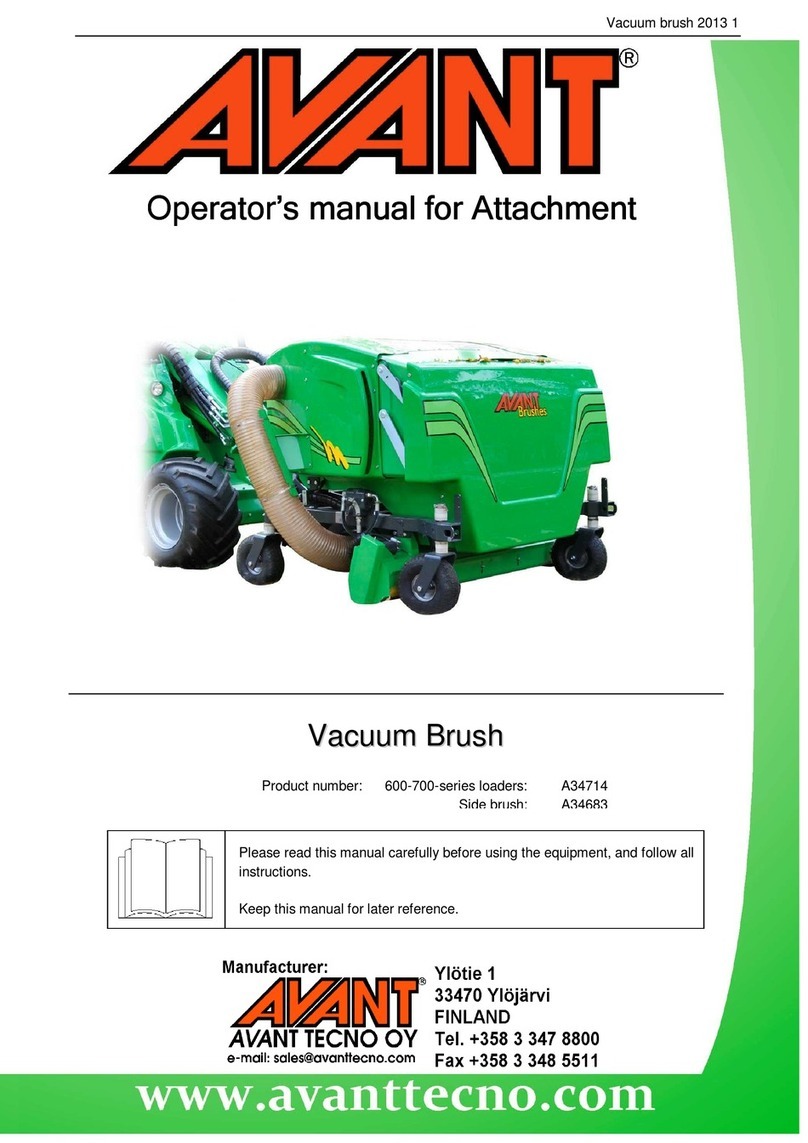
Avantco
Avantco 600 Series Operator's manual for Attachment
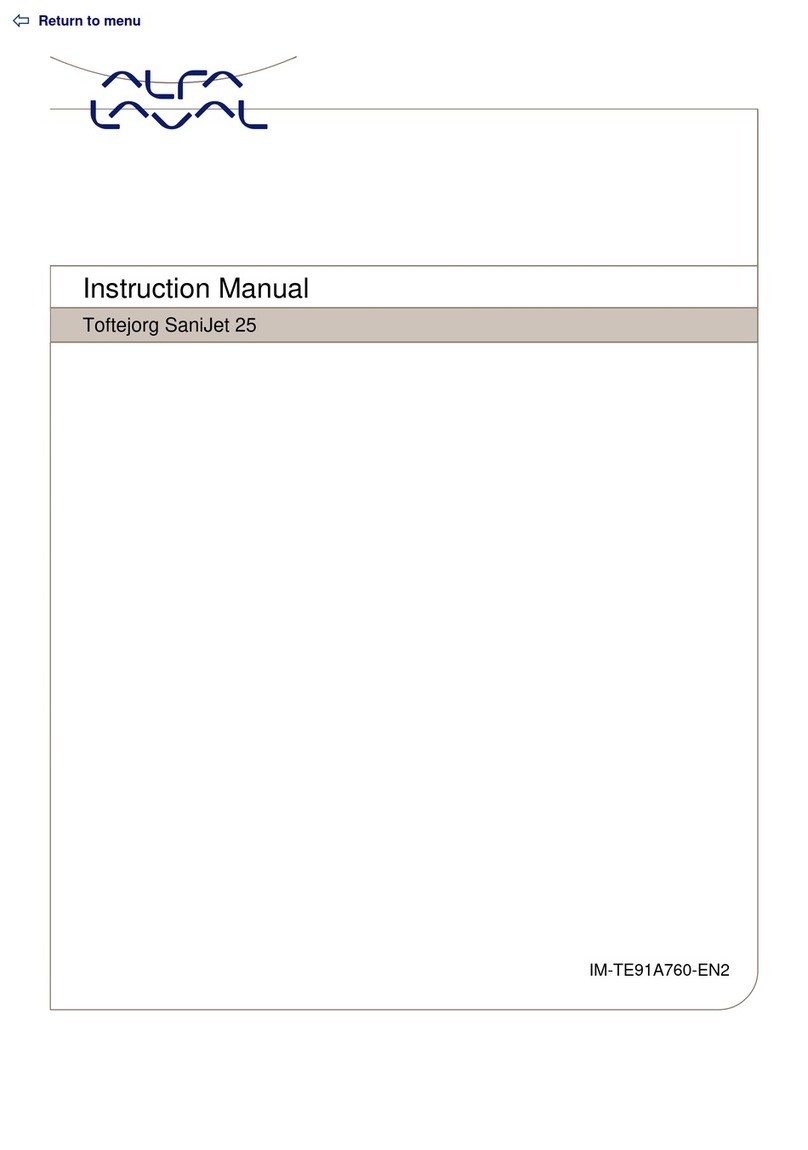
Alfalaval
Alfalaval Toftejorg SaniJet 25 instruction manual

